A Voice Crying Out in the Wilderness
Reverend David Rice (class of 1761) took to the floor to address Kentucky’s first Constitutional Convention in 1792. Despite the fact that no written accounts of the moment remain, one would expect that those assembled in Danville quietly anticipated what “Father Rice” had to say. He had certainly proven himself worthy of his colleagues’ respect. Raised in a family of modest means, Rice had worked his way through the College of New Jersey and faithfully served the Presbyterian Church for decades. When he arrived in Kentucky in 1783, he founded the state’s first permanent Presbyterian congregation, taught the first Latin grammar school out of his home, and played an instrumental role in developing the Transylvania seminary.[1] In this moment, however, he did not speak on purely ecclesiastical matters. Instead, Rice leveraged his status to deliver a radical speech, declaring that there was only one acceptable way for the convention to proceed: end slavery in Kentucky of “our own free choice,” and “wash our hands of this guilt.”[2]
Rice first approached the issue from a philosophical point of view, arguing that slavery was inconsistent with the founding principles of the nation and their nascent state. If all men were endowed with rights to their freedom by their creator, he asked:
On what is [the right to hold slaves] founded? Whence was it derived? Did it come from heaven, from earth, or from hell? Where is the charter? In whose hands is it lodged? Let it be produced, and read, that we may know our privilege.
Borrowing the language of the philosopher John Locke—who would have been familiar to men who had quoted him throughout the American Revolution—Rice stated that “the master is the enemy of the slave; he has made open war against him, and is daily carrying it on in unremitted efforts.” Moreover, slavery naturally destroyed “all sense of justice and equity” and eroded the value of free labor.[3]
Rice then began to address the major counterarguments he expected. Dispossession of property, he acknowledged, was a serious complication and called for a “serious answer.” Rice also predicted that the abolition of slavery would discourage immigration into the state and hinder Kentucky’s growth. Most of all he anticipated the fear that freeing slaves would lead to miscegenation (a contemporary term for race mixing) and that Kentucky’s “posterity at length would all be Mulattoes.” And yet, despite anticipating the legislature’s fears, he did little to assuage them. The owners of slave property, Rice declared, were “licensed robbers, and not the just proprietors, of what they claimed.” He offered no compensation for their losses. As for the loss of slaveholding settlers, Rice viewed that prospect as “a most desirable effect.” And concerning the mixing of races he could only admit: “this effect, I grant, it would produce.” These were hardly the reassuring words the convention had hoped to hear.[4]
Unsurprisingly, Rice’s motion for the gradual emancipation of slaves failed, and the minister resigned his seat in the convention soon after. But Rice did gain a measure of support, especially from fellow clergymen and even some slaveholders. Despite the fact that ninety percent of the convention members owned slaves, Rice’s measure only lost by twenty-six to sixteen votes.[5]
The fact that the convention was so closely split on the issue of emancipation reflected uneasiness about slavery throughout Kentucky. Though Rice left the convention defeated, he successfully lobbied the Transylvania presbytery to condemn slavery as a “moral evil” by 1797.[6] Nor was Rice the only Kentuckian to speak out against slavery. As historians James Ramage and Andrea Watkins point out, in the decades that followed “opponents of slavery outside Kentucky noticed that the commonwealth had the strongest antislavery movement of any of the slave states.”[7] At its founding, Kentucky’s status as a slave state was in no way guaranteed.
Although the state’s enslaved population boomed from just under 12,000 in the years before statehood to 225,000 at the outset of the Civil War, after 1820 the rate of increase dropped below the national average and continued to fall.[8] Additionally, Kentuckians held fewer slaves than their out-of-state peers. By 1850 the average slaveholder owned 5.4 slaves and 24% held only one bondsman—giving Kentucky the thirteenth-lowest numbers out of the fifteen slave states. However, nearly 28% percent of white families in the state owned slaves, a figure only exceeded in Virginia and Georgia.[9] Kentucky was a society in which slave capital was thinly but widely distributed throughout a larger-than-average slaveholding class. Perhaps these unusual slaveholding patterns contributed to Kentuckians’ ambivalent attitude toward slavery in the antebellum period. As historian Luke Harlow explains, Kentucky’s white residents “held a ‘neutral’ middle-ground stance towards slavery, navigating between abolitionist and proslavery polarities.”[10]
The first generation of Princetonians to come from Kentucky grew up in this atmosphere: a border state in which slavery was a widespread but oft-debated topic. Ultimately, the majority of Princeton students and graduates from Kentucky held conservative views on race and slavery. Not even the radical David Rice could bring himself to put his ideals into practice and free his slaves—even in his will.[11]
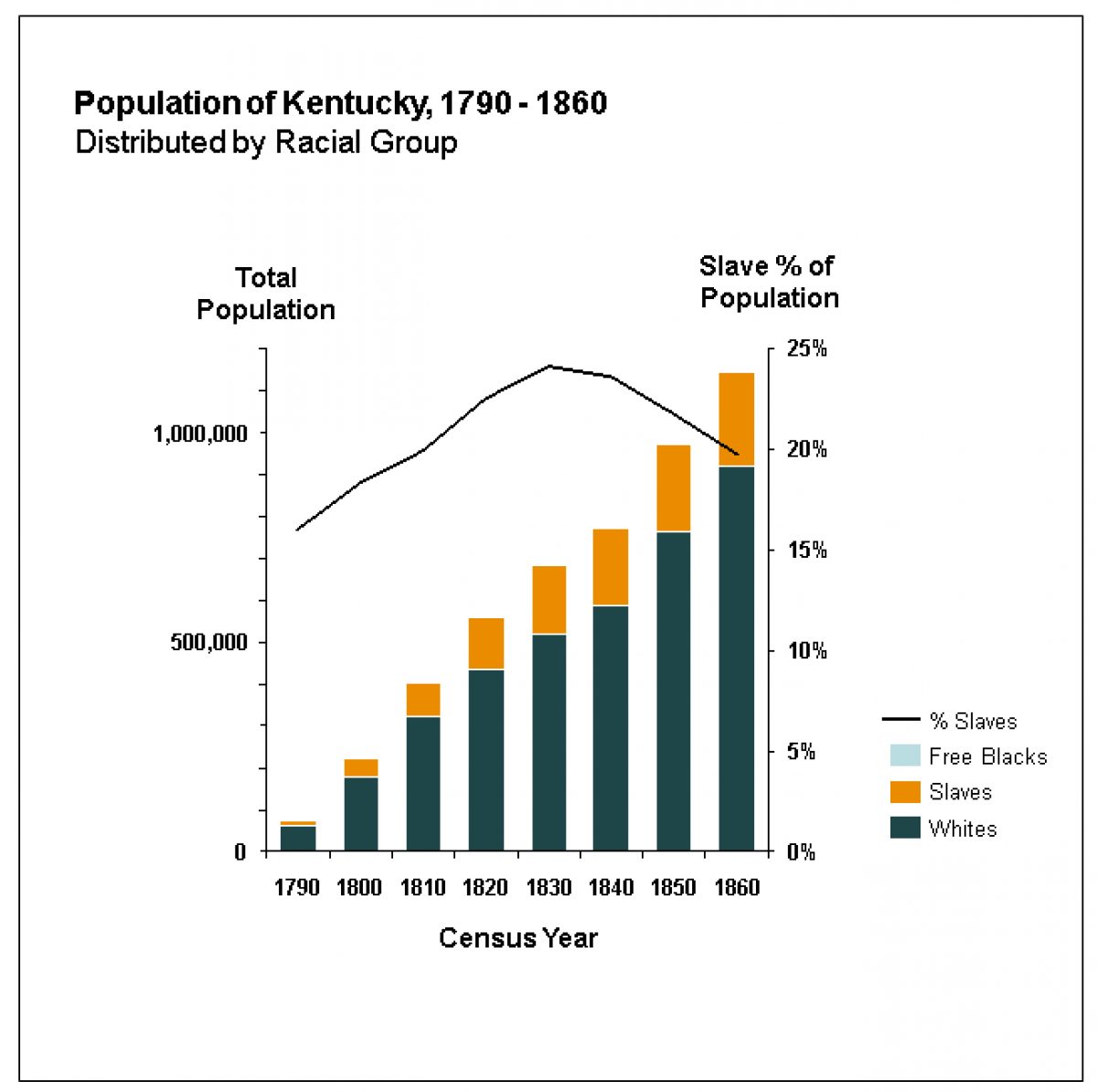
Though the number of slaves increased in Kentucky from 1790-1860, slaves decreased as a percentage of the population from 1830 onwards.
View Primary Sources
The Breckinridge Dynasty
Kentucky families began sending their sons to Princeton barely a decade after the state was admitted to the Union, illustrating the College of New Jersey’s expansive geographical reach and appeal to southern students.[12] One elite Kentucky family, however, delivered more of its sons to Nassau Hall than any other. The Breckinridges—well known both in their home state and the nation at large—stand out not only for the sheer number of family members who attended the college, but also for the mark that they made on both the college and the nation as political leaders in the antebellum period.
Family patriarch John Breckinridge (1760-1806) may have become familiar with the College of New Jersey through colleagues in his home state of Virginia, including his friend James Madison, Princeton alumnus and future President of the United States. Or perhaps he learned of the school through his distant cousin John Brown, a non-graduate from the class of 1778. It was not long after Breckinridge brought his wife and children across the Cumberland Mountains into Kentucky that he sent his eldest son, Joseph “Cabell” Breckinridge (‘1810) to be educated at Princeton.[13] John (‘1818) and Robert Jefferson (‘1820, non-graduate) followed their brother Cabell in the coming years, even after their father’s untimely death in 1806.[14] It was the beginning of a dynasty. Numerous sons, nephews, and grandsons would come to Nassau Hall from the hills of Kentucky for generations to come.
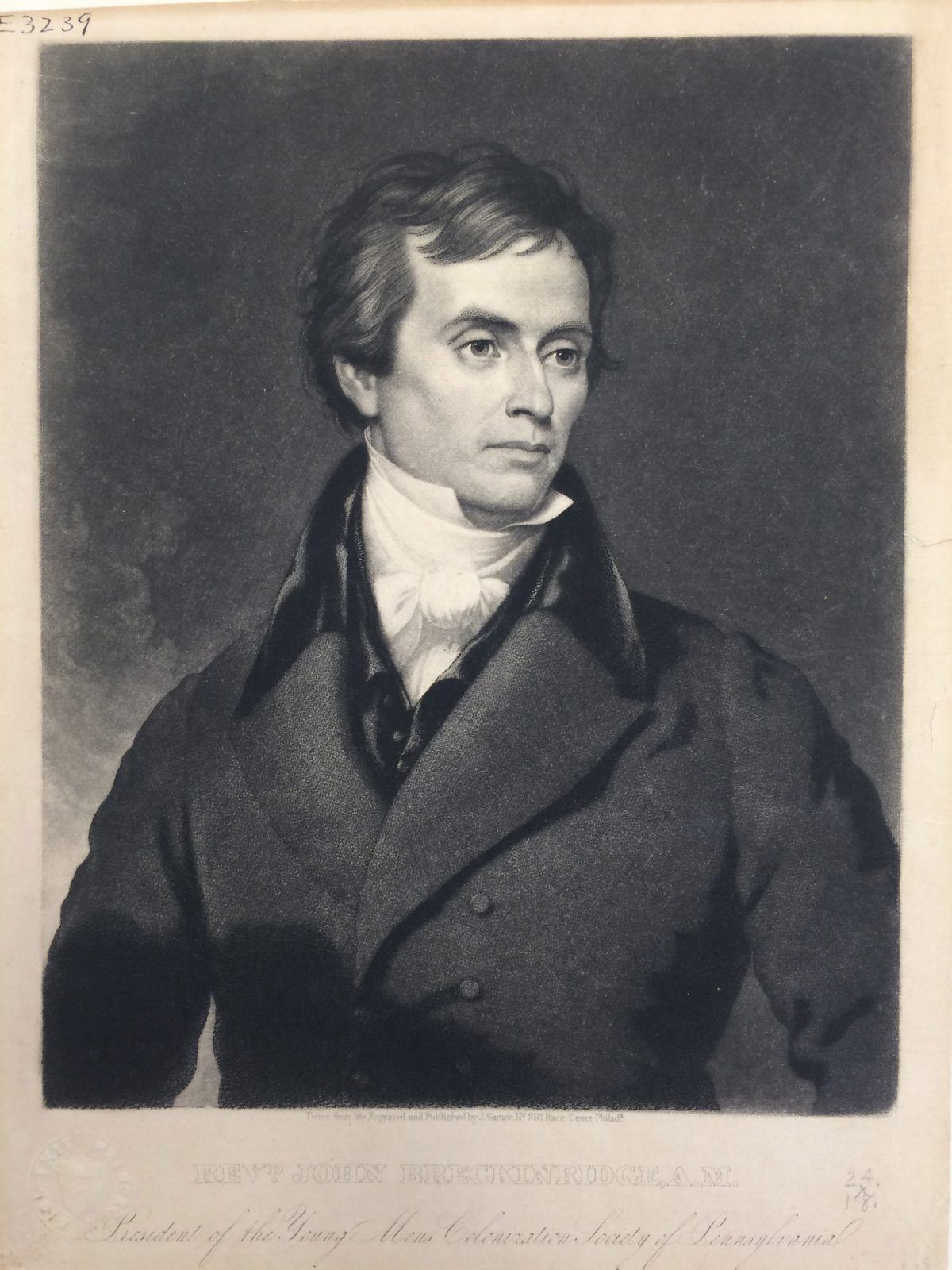
Portrait of John Breckinridge, a Kentucky slaveholder whose family sent multiple generations of children to the College of New Jersey in the 19th century.
View Primary Sources
Cabell did not make it through the college with ease; he was once suspended, and nearly didn’t return because tendering an apology to the administration injured his pride. But the social connections Cabell made at Princeton proved as valuable as his education. Shortly after he came to Princeton, Cabell was joined by another Kentuckian: future abolitionist James G. Birney (‘1810). The two became roommates and close friends, a relationship that would continue through generations of their families.[15] While still a student, Cabell Breckinridge also courted Mary Clay Smith, daughter of the college president Samuel Stanhope Smith. The two were married just a year after Cabell’s graduation.[16]
Smith, who believed that differences between races were nothing but superficial adaptations to different environments, argued that slaves could be elevated to the level of their white masters with the right training and acculturation. Nevertheless, he owned slaves while living at the President’s House on campus.
Smith’s politics closely aligned with the Breckinridge family’s. As historian William C. Davis notes:
The union of the two cemented… two lines of almost identical thought on the proper relationship of the states to the federal government, and on sentiments which supported the fact yet deplored the idea of slavery.[17]
Smith’s ideas about race were controversial for the time, but his effect on his students was profound and widespread. James Birney revered Smith so much that he kept a copy of the professor’s writings on his desk throughout his life. Cabell’s brother, Robert Jefferson Breckinridge also attended the college during the Smith years and served as one of Kentucky’s strongest advocates of African colonization— a scheme that Dr. Smith helped pioneer.[18]
The Colonization Movement in Kentucky
In the early years of statehood, many Kentuckians disliked the idea of slavery but were also concerned about the prospect of free Black people living among them. Such fears are reflected in the 1799 state constitution, which prohibited free African Americans from voting and bearing firearms—rights afforded to them in the original 1792 constitution. By 1808, free Black people were prevented from entering Kentucky and those already in the state were required to carry papers, abide by curfews and maintain employment.[19]
Robert Jefferson Breckinridge was both a student of Samuel Stanhope Smith and a product of his slaveholding environment. He merged the philosophies of slavery he picked up at Princeton with the politics of his state’s famous statesman: Henry Clay, known as “the Great Compromiser.” When Breckinridge entered the state legislature at age 24, he espoused views emphasizing unity, interdependence between the states, and an end to slavery. However, despite early successes in politics, a serious illness in 1828-1829 drove Breckinridge to reconsider the direction of his life and he determined to give up the campaign trail for the pulpit. By 1832, he had completed studies at Princeton Theological Seminary, received his license to preach, and secured an appointment as a minister in Baltimore.[20] Breckinridge did not particularly enjoy his time in Maryland, considering his congregation dense and undeserving of his talents.[21] Eventually, he returned to his home state and became active in both public and religious life.
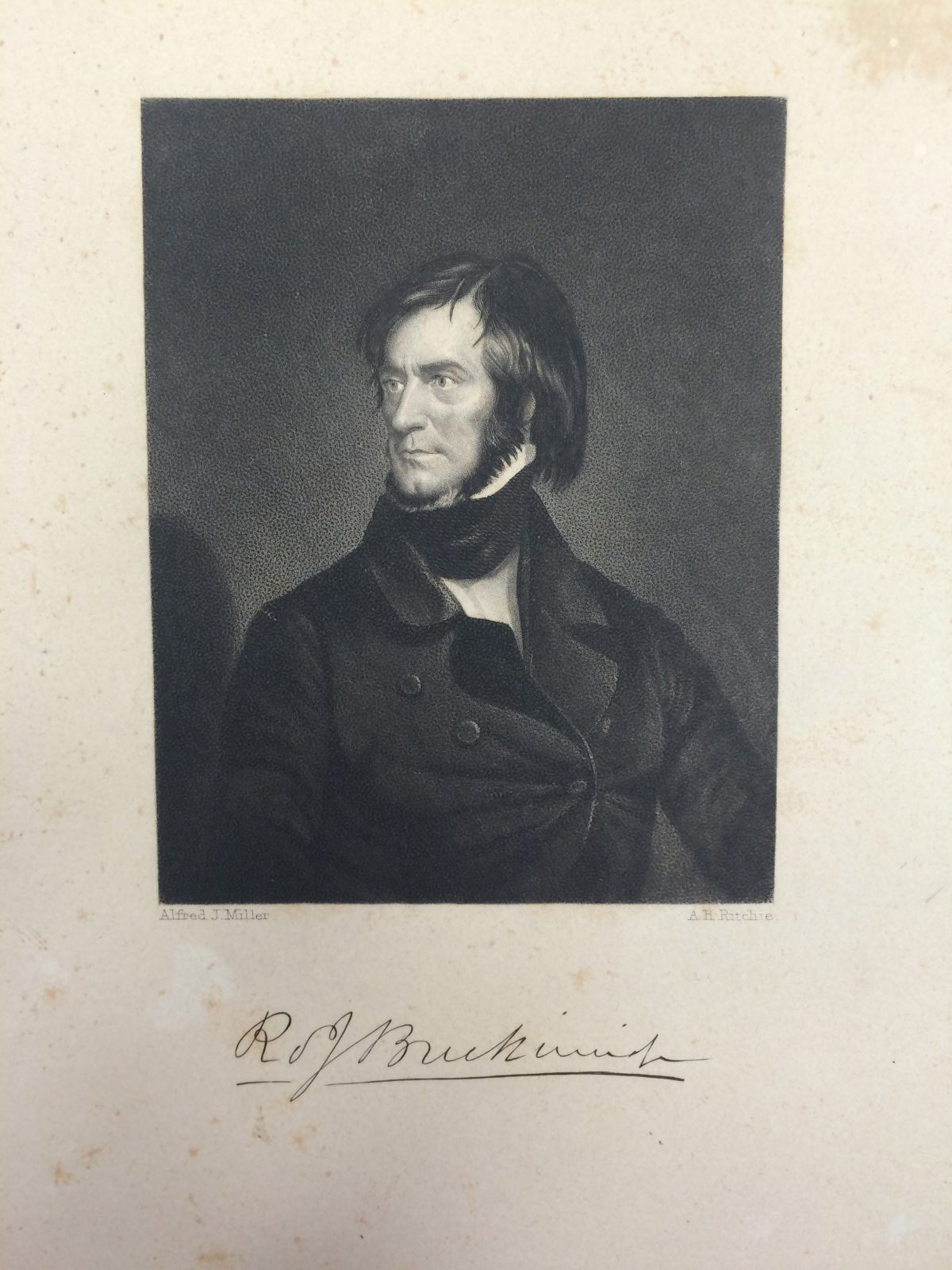
A portrait of Robert Jefferson Breckinridge (class of 1820, non-graduate), a student from Kentucky who was a strong advocate for African colonization.
View Primary Sources
Robert Jefferson Breckinridge recognized the moral and philosophical contradiction between the ideal of an ostensibly free society as set forth in the Declaration of Independence and the reality of slavery. Still, Breckinridge could not rest easy with the prospect of a large free Black population or the possibility of race mixing. Slavery, he conceded, must end—but what then? In the decades following his time at the college of New Jersey, he attempted to reconcile emancipation with his racial prejudices. In one of the most complete expositions of his views, Hints on Slavery (1843), Breckinridge explained that it was not “novel or extravagant” to acknowledge the hypocrisy endemic in owning slaves if one accepted the idea that “all men are by nature free.”[22] That did not mean that he felt that free Black people could coexist with white Americans, however. To resolve this dissonance, Breckinridge turned to the colonization movement.
Colonization—which advocated sending free Black Americans to a colony in Africa—represented the pinnacle of the conservative antislavery movement in the early 19th century, and it was born in Princeton. Drawing on Samuel Stanhope Smith’s arguments that a part of the western territories of the United States should be set aside for the removal and settlement of free Black people , Smith’s students Robert Finley (‘1787) and Charles Mercer (‘1797) founded the American Colonization Society (ACS) in 1816. An ACS affiliate, the Kentucky Colonization Society, was founded in 1829, and by 1832 the state boasted 31 chapters—a number exceeded only by Virginia’s 34 and Ohio’s 33.[23] Colonization was attractive to those who wished to end slavery without having to live on terms of equality with African Americans. For Robert Jefferson Breckinridge, it was an ideal solution: African Americans would leave the United States, Africa would be Christianized, and, eventually, the scheme would be seen as the logical, humane way to end the institution of slavery. Then, the United States would be home only to “a free white race, superior in all respects.”[24]
Although colonization was popular in Kentucky in the 1830s among men like Breckinridge, other slaveholders viewed it as a threat to the established social and economic order. When confronted with accusations that colonization would undermine a slaveholder’s absolute right to their property, Robert Jefferson Breckinridge replied that it was “never the intention of the society to interfere with the rights of the proprietors of slaves; nor has it at any time done so.” Instead, he argued, the doctrine of colonization “took for granted” that slavery was “a great moral and political evil” but provided a path to emancipation that was “cheap, certain, and advantageous to both the parties.”[25]
Colonization also suffered attacks from those who considered its gradual approach to emancipation too conservative. When abolitionist William Lloyd Garrison examined the reports and publications of the ACS, he found “little else than sinful palliations, fatal concessions, vain expectations, exaggerated statements, unfriendly representations, glaring contradictions, naked terrors, deceptive assurances, unrelenting prejudices, and unchristian denunciations.”[26] Nor did the Kentucky Colonization Society feel very generous towards Garrison. They replied that “abolitionism and especially the spirit of modern abolition, will rather retard than promote the cause of emancipation.”[27] Clearly, though many in Kentucky recognized the immorality of slavery, they failed to agree on a path forward.
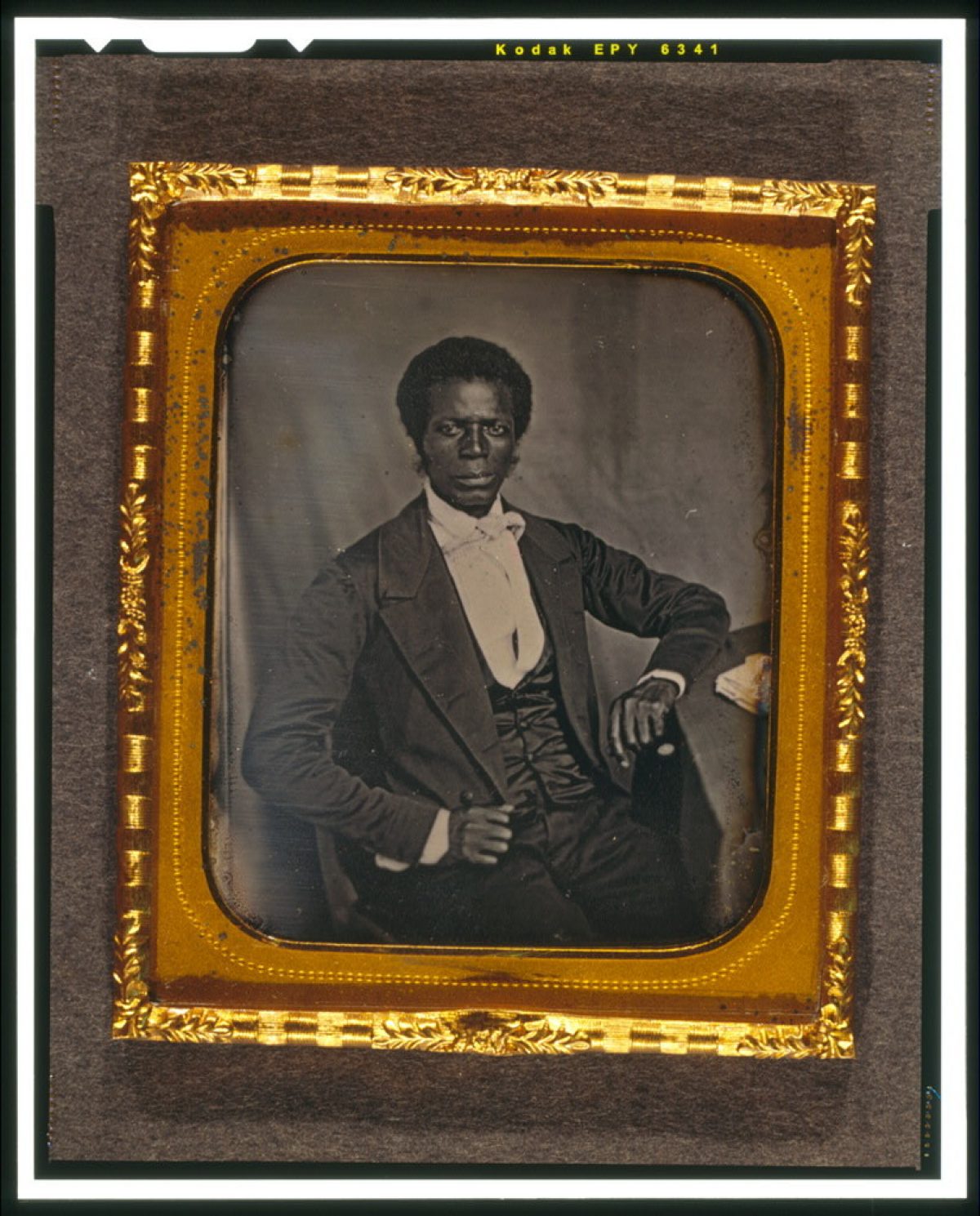
Portrait of James M. Priest, Vice President of Liberia from 1864-68. Priest was born a slave in Kentucky and emigrated to Liberia with the American Colonization Society.
View Primary Sources
James G. Birney
James G. Birney’s early life paralleled that of the Breckinridge boys. He grew up the son of a self-made merchant and planter and personally owned slaves from the age of six, having been given a enslaved boy, Michael, as a companion and playmate by his grandfather.[28] But while his views originally aligned with Robert Jefferson Breckinridge on the matter of colonization, Birney came to rejected the movement for more radical abolitionism.
After losing most of his wealth during the Panic of 1819, Birney abandoned his life as an aristocratic planter, freed almost all of his slaves, and moved to Alabama to practice law. By the 1830s he had made his way to Kentucky, where her began to agitate against slavery. For a time, Birney centered his anti-slavery activities around gradualism and colonization. He was even elected as the Kentucky Colonization Society’s inaugural vice president, despite neither seeking the office nor even being present for the election.[29] But Birney’s interest in colonization, stoked during his years studying under Samuel Stanhope Smith, had been waning for some time, and he was regularly absent at KCS meetings.
Just months after his election, Birney rejected gradualism completely. He freed all of his slaves, resigned his post in the KCS and moved to Cincinnati, where he took up the mantle of abolitionism publicly through his newspaper, The Philanthropist. These choices came at a cost: Birney suffered ostracism, physical violence, and twice endured a frenzied mob casting his printing press into the Ohio River. Nevertheless, he dragged the machine back to land each time and resumed the fight against slavery.[30]
But Birney was the anomaly among his Princeton classmates. The Breckinridges could have also manumitted their slaves, but never did. In fact, as historian Luke Harlow suggests, their conservative “gradual emancipationism had more in common with proslavery viewpoints than with abolitionism.”[31] Even in a state that often debated the future of slavery, Princeton’s sons usually chose a path that favored the institution.
John C. Breckinridge
After his father Cabell died in 1823, John C. Breckinridge’s extended family saw to his education and upbringing. He was especially close to his uncle Robert Jefferson Breckinridge. Indeed, it was Robert who suggested that young John prepare for his career in law by studying at Princeton after he graduated from Centre College in Kentucky.[32] As a result, the two grew even closer, with young John C. taking on many of his uncle’s dearest beliefs. John also came to support the American Colonization Society, though he never formally joined.[33] But when he entered into politics in the 1840s, John C. Breckinridge aligned himself with the Democratic Party (like his grandfather) rather the Whigs (like his father and uncle). Perhaps the cause of this break was what his uncle William termed “the Princeton College influence”—the views of a new generation at the college who, as historian William C. Davis notes, “had grown away from Whiggery, inspired instead by the greatest living hero and movement of his times, Jackson and his Democracy.”[34]
Breckinridge made his first entrance into politics during the election of 1844. He stumped for James K. Polk and the Democrats against a field that included James G. Birney for the antislavery Liberty Party. (As another example of the close connections among Kentucky’s elites, James Birney’s son was John C. Breckinridge’s closest friend at Centre College—as Birney had been John’s father Cabell’s roommate at Princeton.)[35] John C. Breckinridge began to rise to political prominence himself a few years later, during the Mexican-American War.
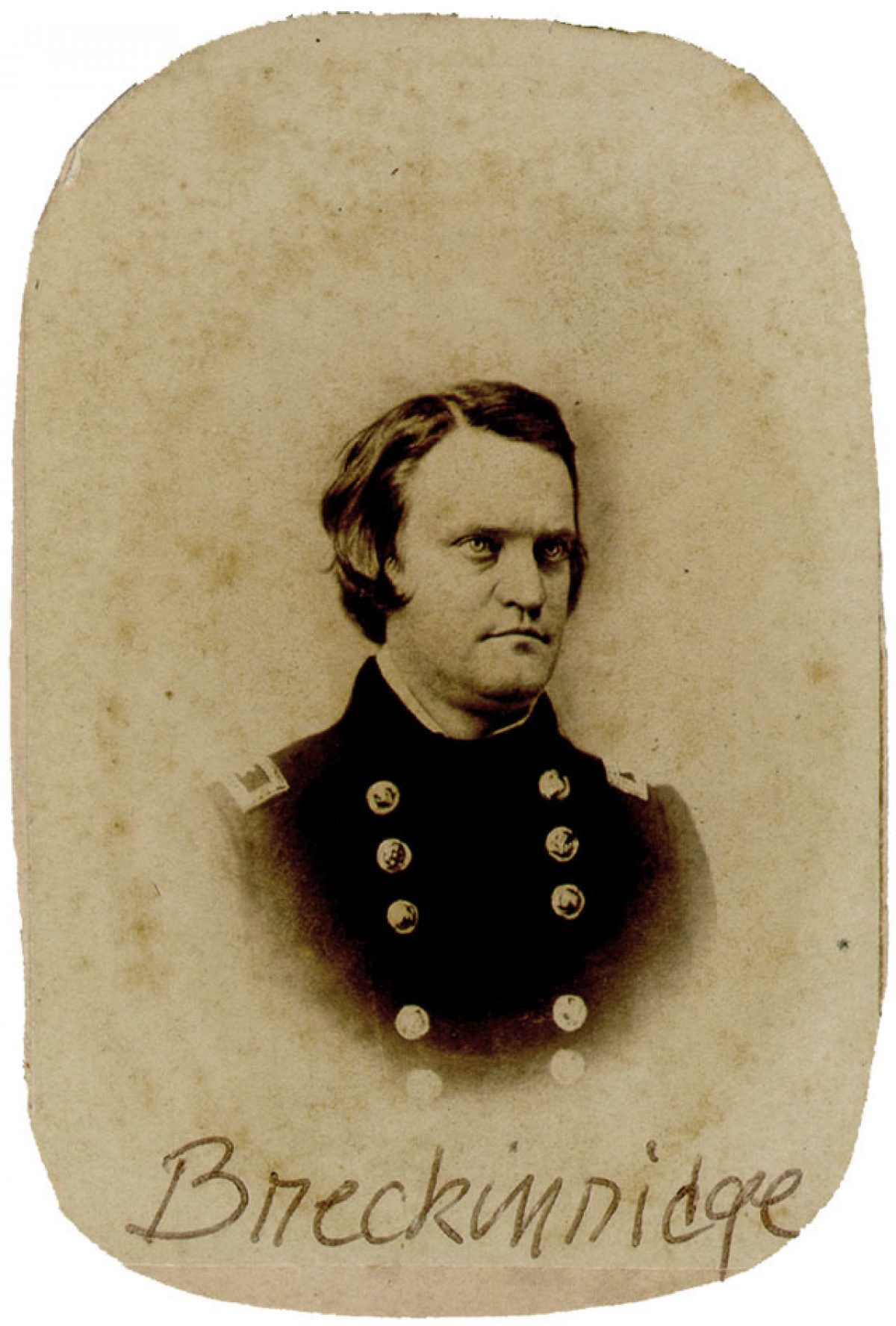
Photograph of Major John C. Breckinridge in US Army Uniform during the Mexican-American War.
View Primary Sources
In 1847, after delivering a well-received oration on the Kentuckians killed at the Battle of Buena Vista, Breckinridge was offered a commission as a major in the U.S. Army. The timing ensured that he did not see battle; shortly after he arrived with his troops in Mexico, the war came to a quick end. This inspired a friendly ribbing by his fond uncle Robert: “the Mexicans heard my young nephew was coming and straight-away they made peace.”[36] However, the relationship between the once-close kinsmen soon began to sour. His uncle could forgive John’s support of Polk in 1844, but when his nephew was elected to the state house as a Democrat in 1849, Robert Jefferson Breckinridge expressed his most sincere disappointment in what he considered a betrayal.[37]
In the next decade, the gulf between the two men continued to widen. John C. Breckinridge was nominated for a position in the state legislature by a bipartisan meeting called to protect slaveholders’ interests. In 1851 Breckinridge won a startling upset for a seat in the U.S. Congress; he served as an effective spokesman for his party and state; and in 1854, he helped whip up the votes for the Kansas-Nebraska Act, which effectively repealed the compromise that had kept the peace between North and South since 1820.[38] Uncle Robert was dismayed when the bill passed. In contrast, John C. Breckinridge proudly claimed that he “had more to do than any other man” in the law’s passage, a sentiment corroborated by future vice president of the Confederacy Alexander Stephens.[39] And in 1856, at 35 years of age, John C. Breckinridge was elected the youngest-ever Vice President of the United States as Democrat James Buchanan’s running mate.
In the election of 1860, Breckinridge ran against fellow Democrat Stephen Douglas, Constitutional Union Party candidate John Bell, and Republican Party candidate Abraham Lincoln. Breckinridge carried the majority of the slaveholding South, splitting the southern vote with Douglas. Lincoln was elected president, and Breckinridge entered the United States Senate. With war looming, Uncle Robert was again disappointed that his nephew did not use his clout as a former presidential candidate, outgoing vice president, and now senator to push for unity between North and South.
Robert Jefferson Breckinridge made his disapproval public in August 1861, when the Danville Quarterly Review (a newspaper he helped edit) printed a critique of John C. Breckinridge, stating:
He had it in his power, by a prompt and decided lead of his party in Kentucky in opposition to Secession, to have made that State well-nigh unanimous for the Union. It was a national calamity that he was not equal to his destiny… His course during the short extra session of the Senate was completely reserved.[40]
Soon after the first southern states seceded, John C. Breckinridge resigned his senate seat, claiming that “the United States as contemplated by the Constitution no longer existed, and that Kentucky was free to choose her own course.”[41] He would go on to serve the Confederacy as a brigadier general and later as the rebellion’s final Secretary of War.[42] His uncle, meanwhile, remained loyal to the Union.
Civil War in a Border State
The story of the Breckinridge family’s fragmented allegiances during the Civil War mirrors the the state of Kentucky as a whole. Robert Jefferson Breckinridge may have been disappointed to lose his nephew to the Confederacy, but seeing his own four sons split their allegiances between the Confederate and Union armies must have been unbearable. Indeed, the steely Robert Jefferson broke down when he heard that his rebel son Willie rode through the night to care for another son—Joseph, a captured Union officer. He wrote to Willie:
I thank God for preserving your life amid so many dangers and for his care of Joseph; and if my poor prayers avail anything, you will both survive these horrible times – and my own departure from them.[43]
Willie’s support of his brother demonstrates that family ties had not completely broken. But perhaps these men were not even as far apart as their different military allegiances suggested.
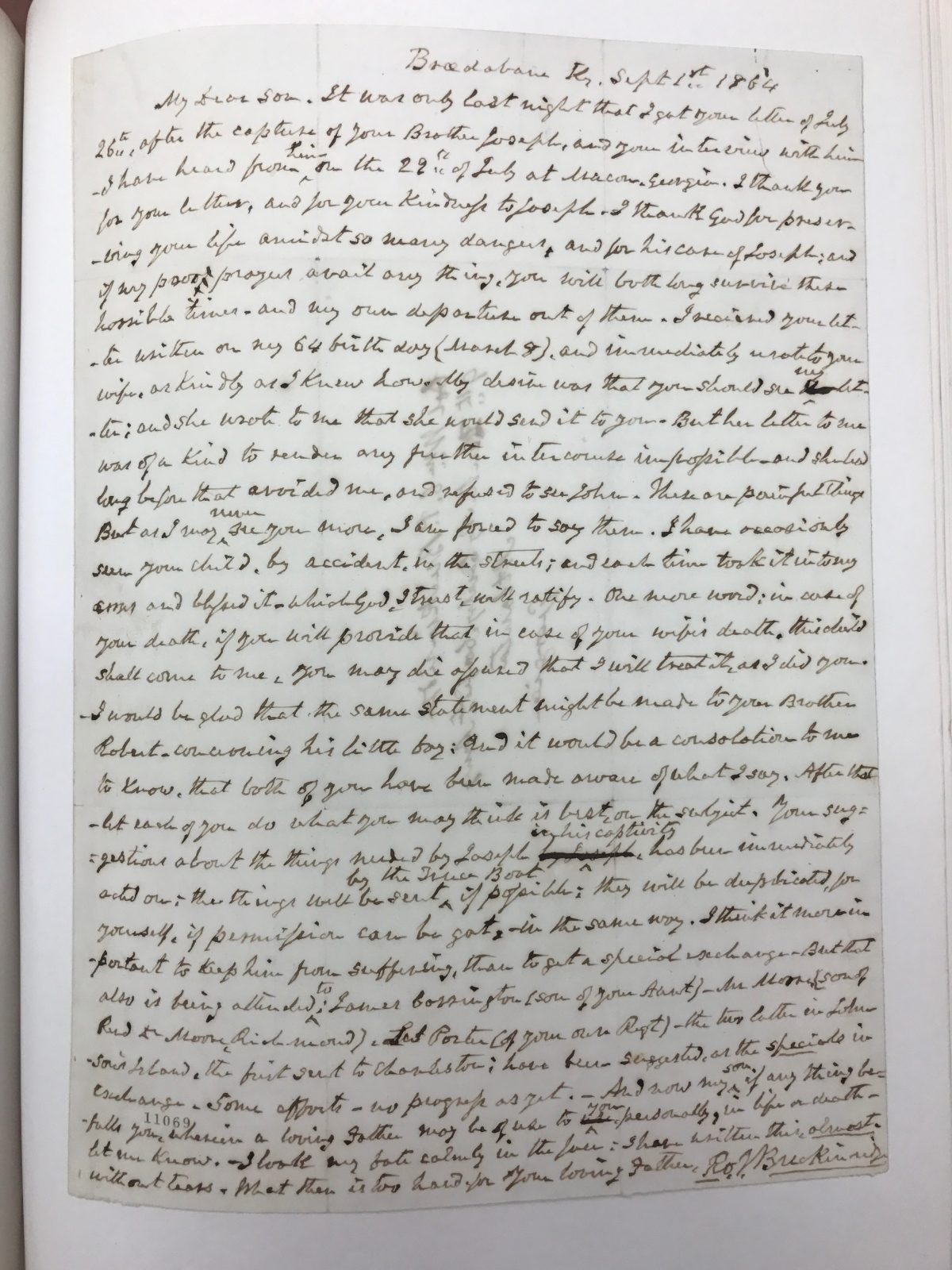
Letter from Robert Jefferson Breckinridge (class of 1820, non-graduate) to his son William Campbell Preston Breckinridge, discussing the capture of Joseph Breckinridge by the Confederate Army.
View Primary Sources
In Kentucky, supporting the Union did not necessarily guarantee opposition to slavery. At the start of the war, Kentucky officially declared its neutrality but ultimately turned to the Union Army for protection from Confederate attacks. And the Emancipation Proclamation specifically exempted Kentucky and other loyal, slaveholding border regions. In 1863, Princeton alumnus Orlando Brown (‘1810) told his son, a captain in the Union Army, not to worry that President Lincoln’s proclamation would impact them:
It is so universally regarded as unconstitutional that it will not be enforced. Public opinion in Military and Civil affairs is a power in the state and has its weight with soldiers and civilians.
Brown’s son had considered resigning from the army on account of the Emancipation Proclamation, but his father advised against it. “At this crisis to flinch now is to give aid to the Rebels and help the secesh to carry Kentucky into the southern confederacy,” he wrote.[44] In 1864, Orlando Brown even authorized his slave, Alexander Sanders, to enter the Union Army. When the war ended and Sanders went free, Brown petitioned for monetary compensation. Taken into consideration with Brown’s letter, the sequence of events suggests that Brown had expected Sanders to return to him after the end of the war, or that he would be compensated accordingly for the loss of his property.
Robert Jefferson Breckinridge freed at least one slave in his lifetime, a 27-year-old man named Clarke whom the minister manumitted in 1837.[45] Despite the excoriating antislavery rhetoric he periodically delivered from his pulpit, however, Breckinridge continued to own slaves for decades after. And like Orlando Brown, he struggled to face what the Civil War really meant for slaveholders and enslaved people alike. In May 1864, Breckinridge discovered that several of his slaves—including a man named Davy Sr.—had fled to a nearby Union Army outpost, Camp Nelson. Breckinridge submitted a formal petition with the general stationed there for the runaways’ return. A Union man at heart, he was “willing for the man [Davy Sr.] to enlist in the army.” But though he acknowledged that Davy Sr. might be of use to the cause, he demanded that the general return the remaining fugitives. He ended his memorandum ominously: “the others had better be returned to me.”[46] Breckinridge was not successful with his petition, and his threats apparently held little weight. In late summer he returned to Camp Nelson to leave a full account of the 21 slaves he believed were being harbored there by the Union Army.[47]
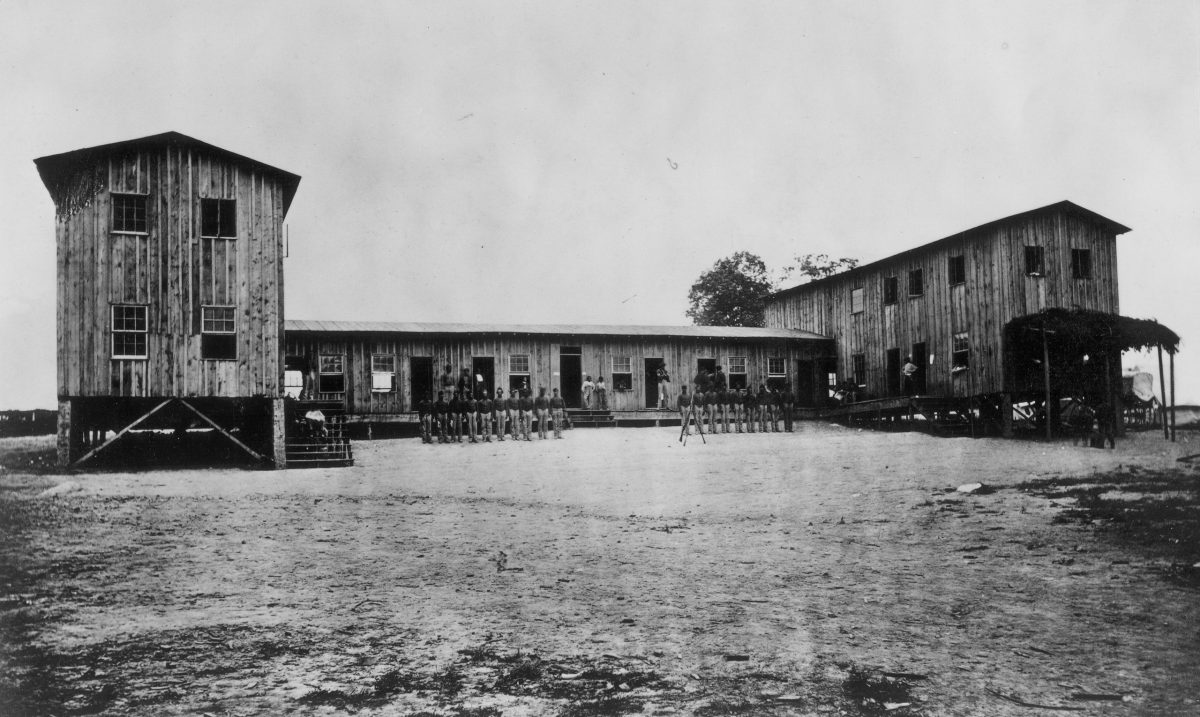
African-American troops at Camp Nelson, the site of Robert Jefferson Breckinridge’s confrontation with General Fry about returning runaway slaves.
View Primary Sources
Breckinridge had to know that he was fighting a losing battle to regain possession of the runaway slaves. On April 4, 1864 (a full month before Breckinridge delivered his first memorandum to Camp Nelson), the United States Senate approved the 13th Amendment, which would abolish slavery throughout the nation—though the amendment would not become the law of the land until it passed in the House and was ratified by the states.
This was not the way Robert Jefferson Breckinridge had envisioned slavery ending. He had been a gradualist from his days at Princeton, supporting colonization and a slow abolition of slavery over time. And yet, though he also claimed to hate slavery as “an ulcer eating its way into the very heart” of Kentucky, he—like his home state as a whole—could not let it go.[48]
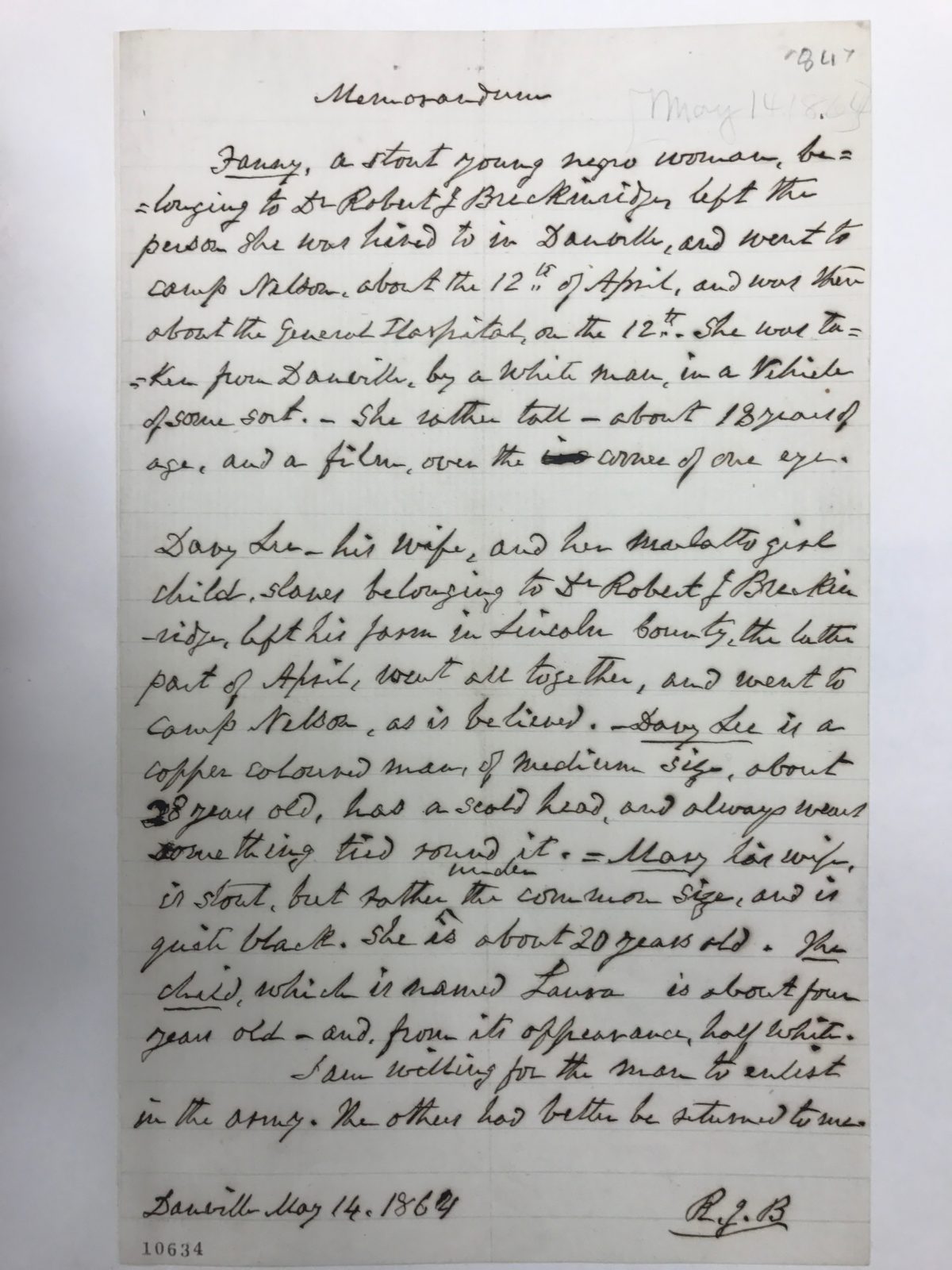
Memorandum by Robert Jefferson Breckinridge (class of 1820, non-graduate) detailing slaves who fled to the Union Army.
View Primary Sources
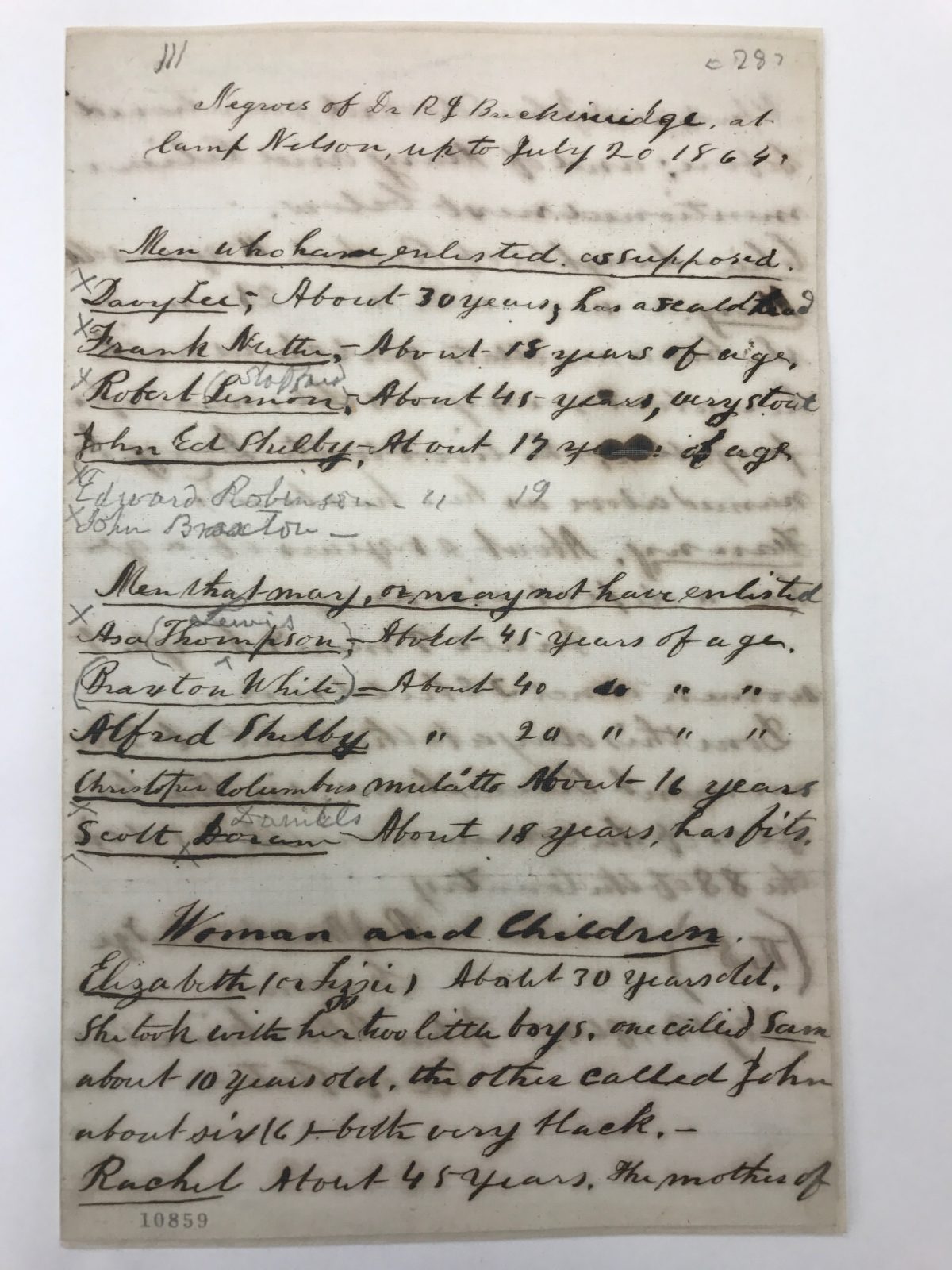
Memorandum by Robert J. Breckinridge (class of 1820, non-graduate) detailing the growing number of slaves fleeing to Union Army lines.
View Primary Sources
References
[1]
James McLachlan, Princetonians, 1748-1768: A Biographical Dictionary (Princeton, NJ: Princeton University Press, 1976), 356.
⤴
[2]
David Rice, Slavery Inconsistent with Justice and Good Policy: Proved by a Speech Delivered in the Convention, Held at Danville, Kentucky (Philadelphia, London: M. Gurney, 1792), 24. The passage reads: “Holding men in slavery is the national vice of Virginia; and while a part of that state, we were partakers of the guilt. As a separate state, we are just now come to the birth; and it depends upon our free choice, whether we shall be born in this sin, or innocent of it… I hope the latter will be our choice; that we shall wash our hands of this guilt.”
⤴
[5]
Andrea S. Watkins and James A. Ramage, Kentucky Rising: Democracy, Slavery, and Culture from the Early Republic to the Civil War (Lexington, KY: Kentucky Historical Society, 2011), 258; Kentucky Constitutional Convention, Journal of the First Constitutional Convention of Kentucky: Held in Danville, Kentucky, April 2 to 19, 1792 (State Bar Association of Kentucky, 1942), 4.
⤴
[6]
McLachlan, Princetonians, 1748-1768, 357. Although not present at the constitutional convention, Robert W. Finley, another Princeton minister in Kentucky, could not reconcile the immorality of slavery with his ministry and freed all 14 of his father’s slaves when he acquired the right to do so in 1796.
⤴
[7]
Watkins and Ramage, Kentucky Rising, 257.
⤴
[8]
Ibid., 238; Lowell H. Harrison and James C. Klotter, A New History of Kentucky (Lexington, KY: University Press of Kentucky, 1997), 99.
⤴
[9]
Watkins and Ramage, Kentucky Rising, 237.
⤴
[10]
Luke E. Harlow, Religion, Race, and the Making of Confederate Kentucky, 1830 - 1880, Cambridge Studies on the American South (New York: Cambridge University Press, 2014), 14.
⤴
[11]
John Patrick Daly, When Slavery Was Called Freedom: Evangelicalism, Proslavery, and the Causes of the Civil War (Lexington, KY: University Press of Kentucky, 2015), 46.
⤴
[12]
Asa K. Lewis, Princeton’s first student from Kentucky, was the son of Thomas Lewis—a prominent political man who administered the oath of office to Kentucky’s first governor—but it seems that he lacked any close familial ties to the college. Before attending Princeton, he studied at Transylvania University, a school organized by Princeton alumnus David Rice. Lowell H. Harrison, Kentucky’s Road to Statehood, (Lexington, KY: University Press of Kentucky), 132, 138.
⤴
[13]
James C. Klotter, The Breckinridges of Kentucky (Lexington, KY: University Press of Kentucky, 2015), 33.
⤴
[14]
Of the four Breckinridge sons who lived to maturity, three attended the College of New Jersey. The fourth and youngest, William Lewis Breckinridge, can be said to have married into the Princeton family by way of Samuel Stanhope Smith’s granddaughter, Frances Prevost. Alexander Brown, The Cabells and Their Kin: A Memorial Volume of History, Biography, and Genealogy (Houghton, Mifflin & Company, 1895), 511–512.
⤴
[15]
William Birney, James G. Birney and His Times (New York: D. Appleton and Company, 1890), 25.
⤴
[16]
Klotter, The Breckinridges of Kentucky, 96.
⤴
[17]
William C. Davis, Breckinridge: Statesman, Soldier, Symbol, Southern Biography Series (Baton Rouge, LA: Louisiana State University Press, 1974), 8.
⤴
[18]
The reason Robert Jefferson Breckinridge never graduated from the college, as his grandson once explained to the Princeton Alumni Weekly, was that when the member of Whig was ambushed with a club in his room by an unruly Clio from Texas, he flipped a table onto the attacker and then “picked up a chair and struck him on the head, smashing the chair and knocking the Texan unconscious.” Although Breckinridge was quickly acquitted when the attacker’s intentions came to light, he had stirred the anger of the Clios and his brother John advised him to leave the college. (Letter from Ethelbert Warfield, “Princeton Alumni Weekly,” January 17th, 1930 in “Robert Jefferson Breckinridge, ‘1812 NG”, Box 78, Undergraduate Alumni Records, Princeton University Archives, Department of Rare Books and Special Collections, Princeton University).
⤴
[19]
Watkins and Ramage, Kentucky Rising, 260.
⤴
[20]
Klotter, The Breckinridges of Kentucky, 45, 50.
⤴
[23]
Ramage and Watkins, Kentucky Rising, 261.
⤴
[24]
Breckinridge, Hints on Slavery, 23.
⤴
[25]
Robert J. Breckinridge, An Address Delivered before the Colonization Society of Kentucky, at Frankfort, on the 6th Day of January, 1831 (Frankfort, KY: A.G. Roges, 1831), 19.
⤴
[26]
William Lloyd Garrison, “Exposure of the American Colonization Society” in Selections from the Writings of William Lloyd Garrison, ed. Stephen Railton, (Charlottesville, VA: 1999), 16.
⤴
[27]
Danville Colonization Society, “Constitution of the Danville Colonization Society and Proceedings of Meetings, May 16, 1829 to May 15, 1835,” quoted in Lowell Harrison, The Antislavery Movement in Kentucky (Lexington, KY: University Press of Kentucky, 2014), 32.
⤴
[28]
“Here Birney spent his childhood, playing with his numerous Gillespie, Whelan, and Reed cousins or roaming the woods and pastures with Michael, the colored boy whom Grandfather Reed had given him when he was only six.” Betty Fladeland, James Gillespie Birney, (Ann Arbor, MI: University of Michigan, 1952), 3.
⤴
[29]
Harlow, Religion, Race, and the Making of Confederate Kentucky, 1830 - 1880, 38.
⤴
[30]
Matthew Salafia, Slavery’s Borderland: Freedom and Bondage Along the Ohio River (Philadelphia: University of Pennsylvania Press, 2013), 201.
⤴
[31]
Harlow, Religion, Race, and the Making of Confederate Kentucky, 54.
⤴
[32]
Davis, Breckinridge: Statesman, Soldier, Symbol, 15.
⤴
[35]
Frank Hopkins Heck, Proud Kentuckian, John C. Breckinridge, 1821-1875, The Kentucky Bicentennial Bookshelf (Lexington, KY: University Press of Kentucky, 1976), 9; Davis, Breckinridge, 30.
⤴
[36]
Klotter, The Breckinridges of Kentucky, 103; Davis, Breckinridge, 40.
⤴
[37]
Klotter, The Breckinridges of Kentucky, 103.
⤴
[38]
Heck, Proud Kentuckian, 24.
⤴
[39]
Ibid., 41; Klotter, The Breckinridges of Kentucky, 108.
⤴
[40]
Robert Jefferson Breckinridge, “The Secession Conspiracy in Kentucky; and its Overthrow, with the Relations of Both to the General Revolt” in The Danville Quarterly Review, Volume 2 (Danville, KY: 1862), 222.
⤴
[41]
Heck, Proud Kentuckian, 105.
⤴
[42]
Stephen Hess, America’s Political Dynasties: From Adams to Clinton (Washington, D.C.: Brookings Institution Press, 2015), 266.
⤴
[43]
All four of Robert Jefferson’s sons survived the war, though his son Charles died in 1867 while serving in the army in Alabama. Robert Jefferson Breckinridge, “Letter to William C. P. Breckinridge,” 1 September 1864, vol. 234, Breckinridge Family Papers (1752-1965), Manuscripts Division, Library of Congress; William H. Townsend, Lincoln and the Bluegrass (Lexington, KY: University Press of Kentucky, 2015), 331.
⤴
[45]
Special thanks to Lezli Davis and Michael Williams for bringing Clarke's story to the attention of the Princeton & Slavery Project. As discussed in an email between Davis and Isabela Morales dated 30 April 2020, the original manumission document for Clarke is in their possession.
⤴
[46]
Robert Jefferson Breckinridge, Memorandum, May 1864, vol. 234, Breckinridge Family Papers (1752 – 1965), Manuscripts Division, Library of Congress.
⤴
[47]
Ibid., Memorandum, 19 July 1864.
⤴
[48]
Breckinridge, Hints on Slavery, 9.
⤴













